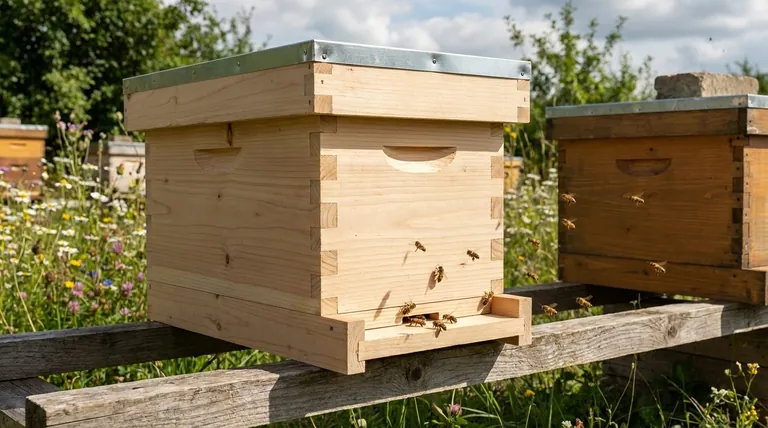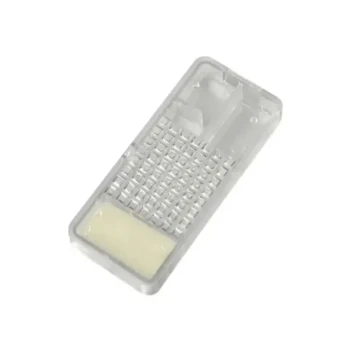By far, the most common standard nucleus hive is the 5-frame nuc. This configuration is so widespread that when experienced beekeepers simply say "nuc," they are almost always referring to a 5-frame version. Its popularity stems from providing a balanced and stable foundation for a new honey bee colony.
While the 5-frame nuc is the undisputed industry standard, the term "standard nuc" primarily distinguishes it from smaller "mating nucs." Understanding the different frame counts and materials available is essential for selecting the right tool for your specific beekeeping goal.

Defining the "Standard Nuc"
Before exploring variations, it's crucial to understand what makes a nuc "standard." The term primarily separates it from a specialized type of miniature hive.
### Standard vs. Mating Nucs
There are two main categories of nucs. A standard nuc is designed to house a small but complete and growing honey bee colony. Its purpose is to be a viable starter hive that can eventually be transferred into full-sized equipment.
In contrast, a baby or mating nuc is a much smaller, specialized box used almost exclusively for raising and mating new queen bees. It is not intended to grow into a full colony.
### The 5-Frame Nuc: An Industry Benchmark
The 5-frame nuc is the benchmark because it provides the ideal balance of resources for a new colony to thrive. It contains a laying queen, bees of all ages, and frames of brood, honey, and pollen.
This size is half the width of a standard 10-frame Langstroth hive box, making the transfer of frames simple and direct. It's large enough to be stable but small enough to be easily managed and transported.
Exploring Variations Beyond the Standard
While the 5-frame model dominates, nuc boxes do come in other configurations and materials, each suited for different purposes.
### Frame Count and Its Purpose
Nucs are available in several sizes. Besides the common 5-frame deep, you may encounter 4-frame, 6-frame, or even 2-frame versions.
Smaller nucs (2-4 frames) are often used for making quick splits from a strong hive or for short-distance transport. Larger 6-frame nucs give a colony slightly more room to expand before needing to be moved.
### Material Choices and Their Uses
The material of the nuc box often dictates its intended use and longevity.
- Waxed Cardboard: These are inexpensive and lightweight, making them ideal for commercial beekeepers who sell and transport large quantities of nucs. They are considered temporary.
- Plastic: Many modern nucs are made of durable, corrugated plastic. They are reusable, easy to clean, and often include features like built-in ventilation and space for feeders.
- Wood: Wooden nuc boxes are the most durable and offer the best insulation. They are an excellent long-term investment for beekeepers who plan to raise their own nucleus colonies or overwinter smaller colonies.
Understanding the Trade-offs
Choosing a nuc involves more than just picking the most common option. Each choice comes with clear advantages and disadvantages.
### The Risk of Smaller Nucs
While a 2-frame or 4-frame nuc might seem like a bargain, it contains fewer bees and resources. This makes the colony more vulnerable to weather changes, pests, and dwindling food stores, increasing the risk of failure, especially for new beekeepers.
### The Limits of a 5-Frame Nuc
A 5-frame nuc is a starter home, not a permanent residence. A healthy, growing colony will quickly fill the space. If not transferred to a full-sized hive in a timely manner, the colony will likely run out of room and swarm.
### Material Durability vs. Cost
Waxed cardboard is cheap but is not a long-term housing solution; it will degrade with exposure to the elements. Wood is the most "bee-friendly" and durable material but is also the heaviest and most expensive option. Plastic sits in the middle, offering a balance of durability and affordability.
Making the Right Choice for Your Goal
Your specific objective should guide your decision when acquiring a nuc.
- If your primary focus is starting your first colony: A 5-frame nuc is the most reliable and forgiving choice, giving you the best chance of success.
- If your primary focus is selling bees on a commercial scale: Inexpensive and lightweight waxed cardboard nucs are the industry standard for efficient transport and sale.
- If your primary focus is raising your own replacement colonies or queens: Durable wooden or plastic 5-frame nucs are a sound investment for long-term apiary management.
Understanding these fundamentals empowers you to select the precise tool needed for a thriving apiary.
Summary Table:
| Nuc Type | Frame Count | Primary Use | Key Advantage |
|---|---|---|---|
| Standard Nuc | 5 Frames | Starter Colony | Balanced, stable foundation |
| Mating Nuc | 1-3 Frames | Queen Rearing | Small, specialized |
| Commercial Nuc | 4-6 Frames | Selling/Transport | Varies by operation |
Ready to build a stronger apiary with the right equipment? HONESTBEE supplies durable, high-quality nuc boxes and beekeeping supplies to commercial apiaries and distributors. We understand the needs of large-scale operations, from reliable 5-frame wooden nucs for long-term colony management to efficient solutions for commercial sales. Let our wholesale-focused expertise help you succeed. Contact HONESTBEE today to discuss your specific needs and volume pricing.
Visual Guide

Related Products
- 5 Frame Wooden Nuc Box for Beekeeping
- Twin Queen Styrofoam Honey Bee Nucs Mating and Breeding Box
- Automatic Heat Preservation 6 Frame Pro Nuc Box for Honey Bee Queen Mating
- Portable Bee Mating Hive Boxes Mini Mating Nucs 8 Frames for Queen Rearing
- Plastic Transporting Bee Packages and Nuc Boxes for Beekeeping
People Also Ask
- What is a common feature of many 5-frame nuc boxes? The Integrated Feeder for Efficient Colony Growth
- What are the benefits of using nucs for beginning beekeepers? Ensure a Successful First Hive with a Head Start
- What are the benefits of moving nuclei around the apiary? Master Strategic Hive Management
- What is the purpose of having a nuc in beekeeping? Build a Resilient & Productive Apiary
- What is the advantage of overwintering a nucleus? A Strategic Asset for Beekeeping Success



















